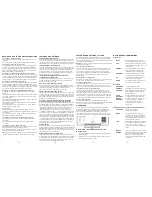
21
22
23
24
250030-01
SPECIFICATIONS
Rated Voltage
20-30 VAC. 24 nominal
Rated A.C. Current
0.050 Amps to 0.75 Amps
continuous per output with
surges to 3 Amps Max
Rated D.C. Current
0 Amps to 0.75 Amps
continuous per output with
surges to 3 Amps Max
Control Range
Heating:
38° to 88°F in 1° Steps
(3° to 31°C in 1° Steps)
Cooling:
60° to 108°F in 1° Steps
(16° to 42°C in 1° Steps)
Thermostat Measurement Range
32° to 118°F
(0° to 48°C)
O.D.T Displayed Range
-54° to 118°F
(-48° to 48°C)
Control Accuracy
± 1°F at 68°F Accuracy
(±0.5°C at 20°C Accuracy)
Minimum Deadband
Economizer Outdoor Threshold
2°F (1°C) (between heating
and cooling)
2°F (1°C) (between heating
and cooling)
NOTE:
This thermostat contains electronic circuitry replacing the
conventional mechanical anticipator
SENSOR FAULTS
There are four distinct sensor faults:
1.
Internal sensor is shorted.
2.
Internal sensor is open.
3.
A remote indoor sensor is shorted.
4.
A remote indoor sensor is open.
When the internal sensor is shorted [the sensed temperature
≥124°F (48°C)], all equipment is turned off and the following icons
are flashed on the LCD:
When the internal sensor is open [the sensed temperature ≤32°F
(0°C)], all equipment is turned off and the following icons are
flashed on the LCD:
An open condition is ignored for the first 20 minutes after
powering the thermostat to allow the equipment to heat the
surrounding environment. This will avoid premature deactivation
of the equipment if the ambient temperature should happen to
be below 32°F (0°C).
DESCRIPTION OF ICONS
DESCRIPTION OF ICONS, continued
DISPLAY
Five (5) YEAR LIMITED WARRANTY
Robertshaw® warrants to the original purchaser that this product
and its component parts will be free from defects in
workmanship and materials for a period of five years from the
date of purchase with proof of purchase.
Warranty Limitations
This warranty begins on the date of purchase
.
Warranty is Void if:
•
The date code is defaced or removed.
•
The product has a defect or damage due to product
alteration, connection to an improper electrical supply,
shipping and handling, accident, fire, flood, lightning or other
conditions beyond the control of the manufacturer.
Five (5) YEAR LIMITED WARRANTY, continued
•
The product is not installed according to the manufacturers
instructions and specifications.
•
The product has been installed near sources of
electromagnetic interference (EMI) such as arcing relay
contacts.
Owner’s Responsibility
•
Provide proof of purchase.
•
Provide normal care and maintenance.
•
Pay for freight, labor and travel.
•
Pay for service calls related to product installation.
•
Return any defective product.
•
In no event shall the manufacturer be liable for incidental or
consequential damages.
This warranty gives you specific legal rights and you may have
others which vary by state and/or province. For example, some
states and/or provinces do not allow the exclusion or limitation of
incidental or consequential damages, so this exclusion may not
apply to you.
The manufacturer’s continuing commitment to quality products
may require a change in specifications without notice.
Robertshaw® RS300N S e rie s Non-Programmable Setback
Thermostats meet CA Title 24 requirements.
This equipment, if installed in strict accordance with the
manufacturer’s instructions, complies with the limits for a Class
B computing device pursuant to Subpart J of Part 15 of FCC
rules.
FCC Regulatory Information
This equipment has been tested and found to comply with the
limits for a Class B digital device, pursuant to part 15 of the FCC
rules. These limits are designed to provide reasonable protection
against harmful interference in a residential installation. This
equipment generates, uses and can radiate radio frequency
energy and, if not installed and used in accordance with the
instructions, may cause harmful interference to radio
communications. However, there is no guarantee that
interference will not occur in a particular installation, If this
equipment does cause harmful interference to radio or television
reception, which can be determined by turning the equipment off
and on, the user is encouraged to try to correct the interference
by one or more of the following measures:
•
Reorient or relocate the receiving antenna.
•
Increase the separation between the equipment and receiver.
•
Connect the equipment into an outlet on a circuit different
from that to which the receiver is connected.
Summary of Contents for RS332NE
Page 4: ...13 14 15 16...
Page 5: ...17 18 19 20...
























